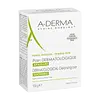What's inside
What's inside
 Key Ingredients
Key Ingredients

 Benefits
Benefits

 Concerns
Concerns

 Ingredients Side-by-side
Ingredients Side-by-side

Disodium Lauryl Sulfosuccinate
CleansingMaltodextrin
AbsorbentSodium Cocoyl Isethionate
CleansingStearic Acid
CleansingAvena Sativa Kernel Flour
AbrasiveWater
Skin ConditioningCetearyl Alcohol
EmollientParaffin
PerfumingCeteareth-6
EmulsifyingPrunus Amygdalus Dulcis Oil
Skin ConditioningPEG-45 Palm Kernel Glycerides
EmulsifyingCitric Acid
BufferingMicrocrystalline Wax
Emulsion StabilisingPolyethylene
AbrasiveCI 77891
Cosmetic ColorantSodium Cocoyl Isethionate
CleansingStearic Acid
CleansingWater
Skin ConditioningSodium Isethionate
CleansingCI 77891
Cosmetic ColorantCocamidopropyl Hydroxysultaine
CleansingPotassium Phosphate
BufferingCeramide NP
Skin ConditioningCeramide AP
Skin ConditioningCeramide EOP
Skin ConditioningCarbomer
Emulsion StabilisingGlycerin
HumectantCetearyl Alcohol
EmollientCeteareth-20
CleansingDimethicone
EmollientBehentrimonium Methosulfate
Sodium Chloride
MaskingSodium Lauroyl Lactylate
EmulsifyingSodium Hyaluronate
HumectantCholesterol
EmollientPhenoxyethanol
PreservativeDisodium EDTA
Dipotassium Phosphate
BufferingTocopherol
AntioxidantCaprylic/Capric Triglyceride
MaskingPetrolatum
EmollientPhytosphingosine
Skin ConditioningXanthan Gum
EmulsifyingEthylene Brassylate
MaskingCetyl Alcohol
EmollientEthylhexylglycerin
Skin ConditioningSodium Cocoyl Isethionate, Stearic Acid, Water, Sodium Isethionate, CI 77891, Cocamidopropyl Hydroxysultaine, Potassium Phosphate, Ceramide NP, Ceramide AP, Ceramide EOP, Carbomer, Glycerin, Cetearyl Alcohol, Ceteareth-20, Dimethicone, Behentrimonium Methosulfate, Sodium Chloride, Sodium Lauroyl Lactylate, Sodium Hyaluronate, Cholesterol, Phenoxyethanol, Disodium EDTA, Dipotassium Phosphate, Tocopherol, Caprylic/Capric Triglyceride, Petrolatum, Phytosphingosine, Xanthan Gum, Ethylene Brassylate, Cetyl Alcohol, Ethylhexylglycerin
Ingredients Explained
These ingredients are found in both products.
Ingredients higher up in an ingredient list are typically present in a larger amount.
Cetearyl alcohol is a mixture of two fatty alcohols: cetyl alcohol and stearyl alcohol. It is mainly used as an emulsifier. Emulsifiers help prevent the separation of oils and products. Due to its composition, it can also be used to thicken a product or help create foam.
Cetearyl alcohol is an emollient. Emollients help soothe and hydrate the skin by trapping moisture.
Studies show Cetearyl alcohol is non-toxic and non-irritating. The FDA allows products labeled "alcohol-free" to have fatty alcohols.
This ingredient is usually derived from plant oils such as palm, vegetable, or coconut oils. There is debate on whether this ingredient will cause acne.
Due to the fatty acid base, this ingredient may not be Malassezia folliculitis safe.
Learn more about Cetearyl AlcoholCi 77891 is a white pigment from Titanium dioxide. It is naturally found in minerals such as rutile and ilmenite.
It's main function is to add a white color to cosmetics. It can also be mixed with other colors to create different shades.
Ci 77891 is commonly found in sunscreens due to its ability to block UV rays.
Learn more about CI 77891Sodium cocoyl isethionate is a natural ingredient from coconut oil. It is an ultra gentle cleanser that gives a nice foam without drying the skin or impacting the skin barrier.
The amount of foam created depends on the amount of sodium cocoyl isethionate used in the product.
This ingredient also helps improve the spreadability of a product.
Learn more about Sodium Cocoyl IsethionateStearic Acid is a fatty acid. It is an emollient, emulsifier, and texture enhancer.
As an emollient, stearic acid helps soften skin. It aids the skin's protective barrier by preventing water loss. It also provides a gentle cleansing effect without stripping away natural oils.
Stearic acid may also be used to enhance the texture of products. It can add volume and stabilize ingredients such as water and oil. This can help water and oil ingredients from separating.
Sources of stearic acid include animal or vegetable fats/oils such as coconut or shea. It can be naturally found in butter, cocoa butter, shea butter, vegetable fats, and animal tallow.
This ingredient may not be Malassezia folliculitis, or fungal-acne safe.
Learn more about Stearic AcidWater. It's the most common cosmetic ingredient of all. You'll usually see it at the top of ingredient lists, meaning that it makes up the largest part of the product.
So why is it so popular? Water most often acts as a solvent - this means that it helps dissolve other ingredients into the formulation.
You'll also recognize water as that liquid we all need to stay alive. If you see this, drink a glass of water. Stay hydrated!
Learn more about Water